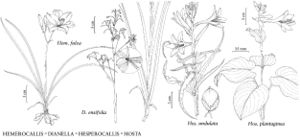Dianella
Gen. Pl., 41. 1789.
| Taxon | Illustrator ⠉ | |
|---|---|---|
 | Hemerocallis fulva Dianella ensifolia Hesperocallis undulata Hosta plantaginea | Yevonn Wilson-Ramsey Yevonn Wilson-Ramsey Yevonn Wilson-Ramsey Yevonn Wilson-Ramsey |
Herbs, perennial, evergreen, scapose, mat-forming, from stout, creeping, scaly rhizomes with fibrous, tuberous roots. Leaves basal, radical, distichous, crowded, sheathing, firm to subcoriaceous; blade linear to broadly ensiform, basal sheaths connate into short tubes, margins entire or serrulate, apex obtuse. Scape elongate, 0.5–1 m. Inflorescences paniculate, loosely branching with short, terminal racemes, bracteate; bracts small. Flowers nodding to ascending; tepals 6, persistent, withering, distinct, subequal, narrowly oblong to ovate, 3–7-veined; stamens 6, distinct; filaments barely adnate to tepal bases, thickened distally; anthers basifixed, dehiscence extrorse, opening by terminal pores that become longitudinal slits; ovary superior, 3-locular, septal nectaries present; style filiform; stigma minute, capitate; pedicel slender, articulate distally. Fruits rather long-persistent, baccate, blue to bluish purple, ovoid-globose. Seeds black, lustrous, ovate, somewhat flattened. x = 8.
Distribution
Introduced; tropical Africa, Asia, Australia, and Polynesia
Discussion
Species 12–20 (1 in the flora).
Selected References
None.
Lower Taxa
"broad" is not a number."thicker" is not a number.